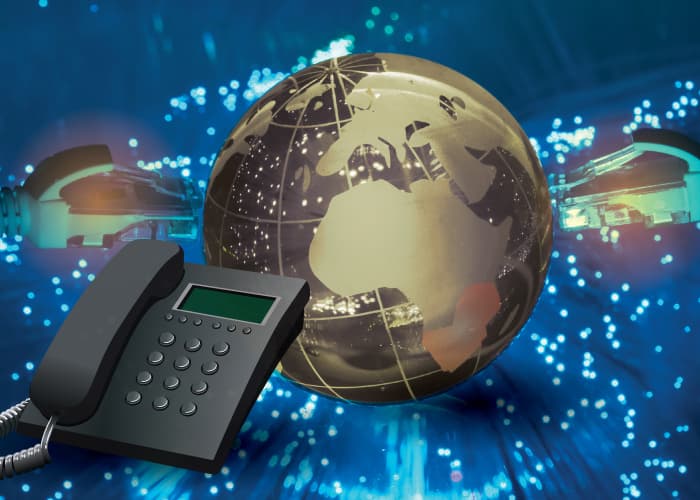You are probably already aware of what a rotary dial telephone looks like. Perhaps you have seen the telephone in an old movie or at an uncommon thrift store, but have you ever wondered how the old school phone made its calls? The rotary telephone was introduced to the public in the early 1900s, with the finger wheel design making its world debut in 1904. Eventually, push buttons were introduced to the telephone model and the rotary dial fell completely out of fashion around the 1980s.
Rotary dial telephones began popping up in personal homes in the United States and Canada during the 1910s. Before the rotary dial was invented and commercialized, people would have to use a phone with a crank on the side. They would need to crank the side of the phone in order to get into contact with an operator, who would then connect that person to the party they wished to call. We’ve come a long way in business communication technology, starting from telegraphs, to rotary dials, push buttons, to the touch sensitive screens we are so accustomed to in the present day. Today, you don’t even have to dial, memorize phone numbers, or check your Rolodex – we can simply tell our smartphone the name of the person we want to call and Siri will dial it for us.
Prior to the Rotary Dial
It’s still important, however, to understand the humble beginnings of the technology that we often take for granted today. The rotary dial was the first telephone to gain popularity in modern households because of how easy it was to use and its sleek design. Before the rotary dial, a calling design existed that was far more complicated to use and therefore, it was not appealing to the everyday user. These phones did use push-button technology, however, they only had three buttons. The three buttons were measured as 100s, 10s, and single units. For instance, if someone were to try calling the number 182, they would first need to press the 100s button, followed by pressing the 10s button eight times and the single units button twice. Now people may think that waiting for a rotary dial to spin back multiple times just to dial a number may be an annoyance, but based on past findings it seems to be infinitely easier to dial 182 using three rotations rather than 11 pushes.
How Does the Rotary Phone Work?
The telephone itself is able to make phones calls by converting sounds (the voice) into a powerful electronic signal that travels through a network of cables, a telephone network, to various other telephones. Telephones contain a microphone that the user would speak into and on the opposite end, the earphone would receive the sound from another location.
The rotary dial was designed as a circular layout that allows the user to insert their finger into a hole that corresponds to different digits of 0-9. Some models also include letters that correspond to each number. In America that would be 2 – ABC, 3 – DEF, 4 – GHI, 5 – JKL, 6 – MNO, 7 – PRS, 8 – TUV, 9 – WXY, and 0 could be used for Z. Once the finger is inserted in the correct location the user would rotate the desired number all the way around the circle until they heard a soft clicking noise. The rotary dial would then automatically rotate back to its starting position and the process would begin again. The rotation from 0 was the longest because it was the furthest from the starting point. However, just because the rotation was longer does not mean the click back was; it would snap back to its starting point as fast as 1 would to the beginning point. This is because the dial used spring action to return to its initial position.
As the dial returns, the system records the pulses. Pulses are recorded by a switch that records the number by a series of steps. For example, if you dial 2, the switch will step twice. The last digit is the only digit that doesn’t use a switch, instead, it uses a wiper arm. The wiper arm process is very similar to the step switch process. In this instance, it is the wiper arm that moves the specific number of times as the digit dialed. That is why when a user finishes dialing, the necessary signals will go out to the intended parties.
Would a Rotary Phone Work Today?
If you find yourself at a thrift store or antique show and stumble upon a working rotary dial phone, before you buy it you might want to consider if it will even work in your home. Based on responses from Quora.com, you should go ahead and pick up that old school telephone because it just might work, depending on your service provider, of course.
One user who works for Verizon Wireless named David Trower offers this little piece of advice for testing out older devices. “To test if a rotary dial would work, try dialing a number that has a 1 in it. For example, to dial 371–4000, dial 3 and then 7 using the push buttons but hang up the phone one time quickly to “dial” the 1 and then dial the rest of the number using the pushbuttons. If this works, you have proven that a rotary phone will work.”
User Talmort O’Dole claimed that if you own one, the phone can even be used when the power goes out. Fortunately, cell phones can also be used as a Plan B when the power goes out. However if you have forgotten to charge your smartphone and the power has gone out, you would be quite fortunate to own a rotary phone in case you find yourself in a situation where you must make an important phone call.
Finally, a third user, Rosario Contarino, encourages consumers to contact their telecom service providers to receive an adapter if their rotary dial telephone is not working.
If you’re looking to add a touch of old-fashioned sophistication to your home, then a rotary dial telephone may be perfect for you. You can find true vintage phones on many popular online retail sites like etsy.com, or if you don’t want to take the risk of your vintage purchase not working on your network, then you can find many updated phones that are designed to look exactly like the classic rotary dial phones at a variety of common retailers.






